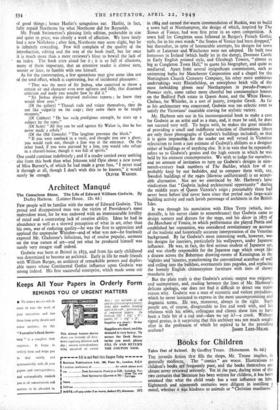Architect Manqué
The Conscious Stone. The Life of Edward William Godwin. By Dudley Harbron. (Latimer House. 12s. 6d.)
FEW people will be familiar with the name of Edward Godwin. This proud and disappointed man was the victim of Providence's most malevolent tease, for he was endowed with an immeasurable fertility of mind and a contrasting lack of creative ability. Ideas he had in abundance as well as a shrewd perception of what in art, other than his own, was of enduring quality—he was the first to appreciate and applaud the unpopular Whistler—and of what was not—he fearlessly exposed Mr. Gladstone's fallacious, but of course popular, sermons on the true nature of art—and yet what he produced himself was surely very meagre stuff indeed.
Godwin was born at Bristol in 1833, and from his early childhood was determined to become an architect. Early in life he made friends with William Burges, an architect of remarkable powers and deplor- able tastes whose Continental Gothic influence upon Godwin was strong indeed. His first successful enterprise, which made some stir
in 1864 and earned the,warm commendation of Ruskin, was to build a town hall at Northampton, the design of which, inspired by The Stones of Venice, had won first prize in an open competition. A town hall for Congleton soon followed in Burges's French Gothic style, for in his own words " the Stones of Venice had been dropped," but thereafter, in spite of honourable attempts, his designs for town halls at Leicester and Winchester were not adopted. He built two fortresses in Ireland (which badly let in the damp), Dromore Castle in Early English pointed style, and Glenbegh Towers, "almost as big as Congleton Town Hall," to quote his biographer, and quite as mediaeval. Apart from several insignificant commissions, such as swimming baths for. Manchester Corporation and a chapel for. the Nottinghani Church Cemetery Company, his other more ambitious undertakings were Rheinfieldon, an amorphous brick villa of the most forbidding gloom near Northampton in pseudo-Francois Premier style, some rather more cheerful but commonplace houses on the Bedford Park estate in Queen Anne, and the White House, Chelsea, for Whistler, in a sort of jaunty, irregular Greek. As far as his architecture was concerned, Godwin was too eclectic even to satisfy the Victorians' insatiable craving for stylistic variety.
Mr. Harbron sets out in his inconsequential book to make a case for Godwin as an artist and as a man, and, it must be said, he does not succeed very well. To begin with, he makes the great mistake of providing a- small and indifferent selection- of illustrations (there are only three photographs of Godwin's buildings included), so that it is quite impossibha, for the reader not well versed in Victorian eclecticism to form a just estimate of Godwin's abilities as a designer either of buildings or of anything else. It is in vain that he repeatedly refers us to Godwin's genius and the high esteem in which he was held by his eminent contemporaries. We wish to judge for ourselves, and no amount of invitation to turn up Godwin's designs in nine- teenth-century back numbers of The Builder, which few of us probably keep by our bedsides, and to compare them with, say, Swedish buildings of the 194os (likewise unillustrated) is an accept- able alternative. Nor are we convinced by Mr. Harbron's lame
vindication that " win lacked architectural opportunity " during the middle years of Queen Victoria's reign ; presumably there had never been before god never been since that period such large-scale building activity and such lavish patronage of architects in the British Isles.
It was through his association with Ellen Terry (which, inci- dentally, is his surest claim to remembrance) that Godwin came to design scenery and dresses for the stage, and his decor in .1875 of the Merchant of Venice, in which performance she played Portia and established her reputation, was considered revolutionary on account of the realistic and historically accurate interpretation of the Venetian background. By far Godwin's most interesting work, however, was his designs for interiors, particularly his wallpapers, under Japanese influence. He was, in fact, the first serious student of Japanese art, and was chiefly responsible for the Japanese rage which swept like a disease across the Bohemian drawing-rooms of Kensington in the 'eighties and 'nineties, transforming the conventional acanthus of wall and ceiling into the lia'filboo, overmantels into pagodas, and replacing the homely English chimneypiece furniture with tiers of showy mandarin jars.
But the plain truth is that Godwin's artistic output was exiguous and unimportant, and, reading between the lines of Mr. Harbron's delicate apologia, one does not find it difficult to detect one major reason why. Godwin was a man of eccentric and violent prejudices, which he never hesitated to express in the most uncompromising and dogmatic terms. lie was, moreover, always in the right. Such people are, of course, disagreeable to live and work with, and his relations with his wibes, colleagues and clients show him to have been a little bit of a cad and—dare we say it?—a crook. Without signal genius, is it surprising that this architect was not much sought after in the' profession of which he aspired to be the presiding


































 Previous page
Previous page